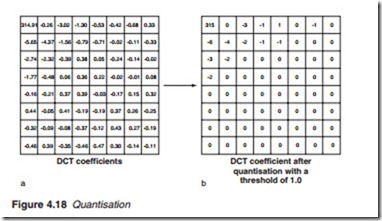Quantising the DCT block
After a block has been transformed, the DCT coefficients are quantised (rounded up or down) to a smaller set of possible values to produce a sim- plified set of coefficients.
or instance, the DCT block in Figure 4.18a may be reduced to a very few coefficients shown in Figure 4.18b if a threshold of 1.0 is applied. Further compression is introduced by a non-linear or weighted quantisa- tion. The video samples are given a linear quantisation but the DCT coef- ficients receive a non-linear quantisation; a different quantisation level is applied to each coefficient depending on the spatial frequency it rep- resents within the block. High quantisation levels are allocated to coeffi- cients representing low spatial frequencies; this is because the eye is most sensitive to low spatial frequencies. Lower quantisation is applied to coefficients representing high spatial frequencies. This will increase the quantisation error at these high frequencies, introducing error noise that is irreversible at the receiver. However, these errors are tolerable since high frequency noise is less visible than low frequency noise. The d.c. coefficient at the top left hand is treated as a special case and is given the highest priority. A more effective weighted quantisation may be applied to the chrominance frames since quantisation error is less visible in the chromi- nance component than in the luminance component.
Quantisation error is more visible in some blocks than in others; one place where it shows up is in blocks that contain a high contrast edge between two plain areas. Then the quantisation parameters can be modi- fied to limit the quantisation error, particularly in the high frequency cells.
